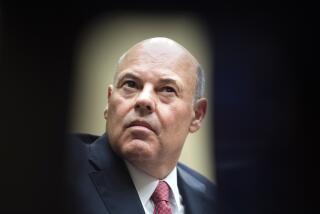Postal Officials Admit Delivery Is Getting Worse
- Share via
WASHINGTON — Mail delivery has worsened in virtually every section of the country instead of rebounding as expected after a dismal performance last winter, postal officials acknowledged Tuesday.
The latest quarterly mail service statistics, obtained by the trade publication Business Mailers Review, mean more trouble for Postmaster General Marvin T. Runyon Jr.
Runyon finishes his second year in office this week and had hoped for a 95% on-time mail delivery rate after reorganizing the Postal Service. But with new spring quarter figures--confirmed by postal officials--showing that just 82% of letters addressed to overnight delivery zones arrive on time, Runyon’s anniversary is marked by a growing number of problems.
The agency’s deficit may hit $2.1 billion this year, agency officials said, more than 50% higher than the $1.3 billion deficit Runyon originally projected. And the Merit Systems Protection Board declared last week that Runyon’s 1992 restructuring of the Postal Service violated reduction-in-force rules, a decision that could force him to reinstate hundreds of displaced managers.
But members of the Postal Service’s own board of governors have said that all of those problems pale by comparison to mail service. As Board Chairman J. Sam Winters put it: Without good service, “our competitors will beat us up.”
The new numbers, which postal officials plan to announce in mid-July, indicate that 82% of the letters that should have been delivered overnight were delivered on time, a drop from 84% in the same period of 1993. On-time deliveries of two-day letters--those traveling up to 600 miles--fell sharply, dropping to 71% from 78%, and punctual handling of three-day mail fell to 77% from 80%. “Service is not as good as we want, and we’re determined to make improvements,” said Sandra Harding, a postal spokeswoman. She pointed to Runyon’s recent decision to eliminate an entire level of regional mail managers and replace them with 10 new area vice presidents. “This is the main reason we fine-tuned the management structure: to improve.”
More to Read
Sign up for Essential California
The most important California stories and recommendations in your inbox every morning.
You may occasionally receive promotional content from the Los Angeles Times.













